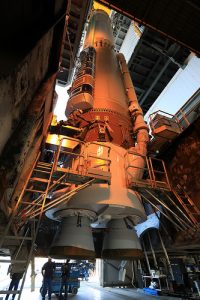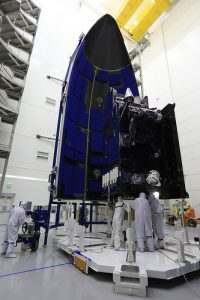
After a few delays, including one created by a hurricane, GOES-R is set for launch on Saturday, November 19. The 1-hour launch window opens at 5:42pm.
The launch was originally slated for November 4. In an ironic turn of events, a hurricane that could have been better forecast by data from the new satellite was responsible for the first major delay. Hurricane Matthew passed by Florida’s Cape Canaveral on Friday October 7th and while not impacting the satellite itself, it did cause minor to moderate damage to the launch infrastructure. In addition to storm damage a minor issue was discovered with the Atlas V booster which has further delayed the launch. In a memo obtained by Weatherboy.com, scientists working on the GOES-R program were told days ago, “In the last few days, a failure of a valve during component-level test at the factory has implicated 4 valves on our launch vehicle…This repair, on top of a stand-down last weekend due to high wind conditions, has consumed the margin in our schedule and will push us beyond the 11/16 launch date.” On Friday, the launch date was updated to the new November 19 launch date.
“It is rocket science after all,” says Steven Goodman, Ph.D., Chief Program Scientist for GOES-R at NOAA Satellites. “NOAA has invested in a robust weather satellite program to ensure its National Weather Service can continue to provide America with accurate, timely forecasts, to include the three satellites we have on orbit now. Once launch occurs, GOES-R will reach the geosynchronous orbit 14 – 16 days after launch. It will undergo a six-month on-orbit check out of all the instruments and become officially operational within one year.” So after the much anticipated launch the weather community will need to wait for months before the new equipment becomes operational and available.
If you were to put this additional wait time in perspective it would seem like a mere moment considering that weather satellite technology has been around for over 50 years. Lockheed Martin has been designing and building weather instrumentation for use on space satellites since the 1960s and it all started with the TRIOS-1 satellite. The operational period of that satellite was only 78 days but it proved that satellites could be useful tools in analyzing and forecasting the weather. Lockheed Martin has made considerable improvements in their design and durability with the latest satellite’s life expectancy being 15 years.

With each new generation of satellite there comes with it a vast amount of new data available from existing instrumentation improvements and new instruments themselves. GOES-R will be no different; in fact there will be a number of new improvements according to Goodman. “GOES-R is flying six new, highly advanced instruments. These instruments are a significant step-up above what our current satellites contain, and will help NOAA improve its ability to forecast weather and monitor solar conditions in space.”
It’s not only the new data that is peaking the interest of the weather community but the speed at which that data will be available. “GOES-R will provide greater imaging, increased resolution and faster coverage, leading to more accurate, timely forecasts and warnings. GOES-R will scan the Earth five times faster at four times the image resolution, and triple the number of channels than NOAA’s current GOES. In addition, GOES-R will host the first ever lightning mapper flown in a geostationary orbit. The lightning mapper instrument will observe not only cloud to ground lightning strikes, but also in-cloud lightning activity,” adds Goodman.
Observing more data in near real time could greatly improve our severe storm warning times explains Goodman. “Scientists believe that an increase in lightning activity, especially in-cloud, may be a precursor to the formation of developing storms. GOES-R will offer new tools to observe total lightning in near real-time.”
All of these improvements will be greatly appreciated by the scientific community and eventually all of those who are affected by the weather. For now the satellite is in the hands of the United Launch Alliance and NASA who will continue to ensure the spacecraft will safely deliver the cargo to it’s reserved spot 22,000 miles above the Earth’s surface.